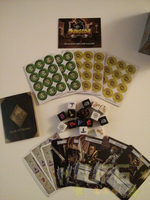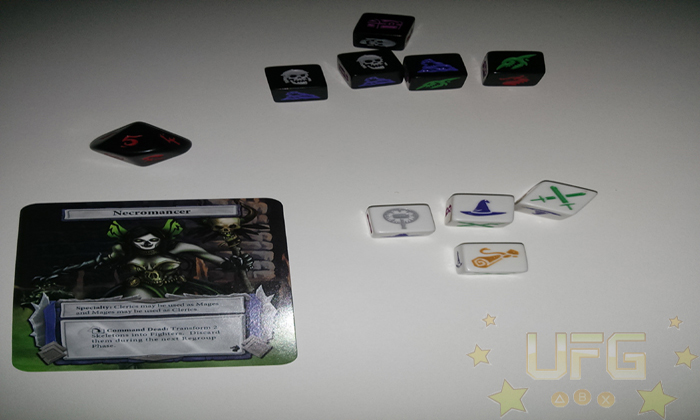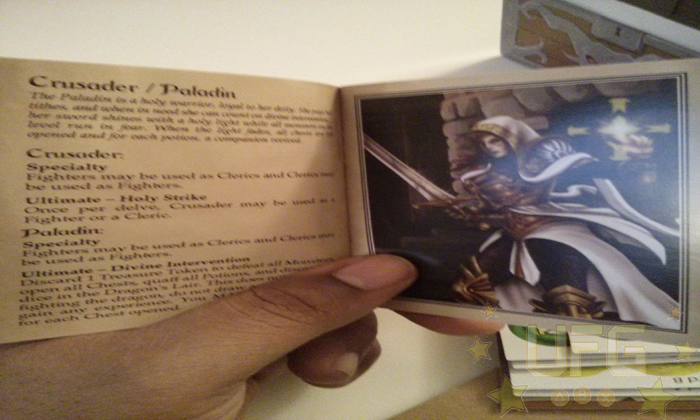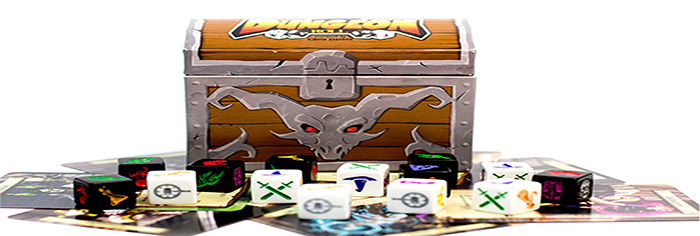UFG Goes Hands on With Dungeon Roll!
Appropriate Ages: 8+
Players: 1-4
Average Game: 15-30 mins.
Cost: $19.99
Released: 2013
Publisher: Tasty Minstrel Games
Designer: Chris Darden
As much as enjoy playing video games, I kind of miss the tabletop experience. I would love to get a bunch of friends together, grab some snacks and spend the next day in half playing Dungeons and Dragons. Alas, due to my responsibilities as husband, father, and Chief Editor at UFG, I seldom have that kind of time. Unless of course I played during summer vacation or some sort of sabbatical; that still wouldn’t be ideal even with the extra “free time” because most of my friends aren’t big on lengthy D&D sessions. So, Monopoly it is…
Thankfully, UFG was able to acquire Dungeon Roll from Tasty Minstrel Games for review. I mean, why not scratch that old RPG itch if I could right? To my surprise though, Dungeon Roll is much more than a nod to the past. It’s also a pleasant reminder that less really is more. Before getting too deep into why I feel that way, let me explain how the game works*.
 In Dungeon Roll, the goal is to get the most experience points over the course of three rounds. This is done by fighting monsters, collecting loot, and ultimately conquering multiple levels of the Dungeon. At the start of the game, each player is given a random hero card to use as their avatar during the game. One player is chosen to delve into the dungeon first as the Adventurer and the person to their left assumes the role of Dungeon Lord, the person who summons monsters. The Adventurer will then roll the 7 party dice (more on them later) to determine who’ll make up their band of companions or party members. Once they’ve been chosen, the Dungeon Lord will set the 10-sided Level Die to 1 and the Adventurer’s first dungeon round beings.
In Dungeon Roll, the goal is to get the most experience points over the course of three rounds. This is done by fighting monsters, collecting loot, and ultimately conquering multiple levels of the Dungeon. At the start of the game, each player is given a random hero card to use as their avatar during the game. One player is chosen to delve into the dungeon first as the Adventurer and the person to their left assumes the role of Dungeon Lord, the person who summons monsters. The Adventurer will then roll the 7 party dice (more on them later) to determine who’ll make up their band of companions or party members. Once they’ve been chosen, the Dungeon Lord will set the 10-sided Level Die to 1 and the Adventurer’s first dungeon round beings.
The rounds are broken into phases, with the first one being the Monster phase. Here, the Dungeon Lord will roll Dungeon Dice equal to the number currently shown on the 10-sided Level Die; so level die reads 2, the Adventurer is on a level 2 dungeon, therefore two Dungeon Dice are rolled. Depending on what is rolled, the dungeon will be populated with monsters (skeletons, goblins, and oozes), treasure chests, or revival potions. In order to clear that level of the dungeon you’ll need to kill all of the monsters present; opening chests and using potions are optional.
Now, the way you defeat monsters is by using one or more of your companions to attack. Once used, the companion will move to the graveyard – a place you designated to take dice out of the game – along with the monster attacked. The battles aren’t always one to one as certain companions are better suited against certain monsters. Let’s say there are three goblins and one skeleton that need dispatching. And in your party you have a Fighter, a Cleric and a Mage. Because you’re out numbered, it might seem like you’d lose the round. However, since the fighter can take out any number of goblins during a round, you can use him and one other companion (the Cleric or Mage) to take out the monsters. After this Monster phase comes the Loot phase. Here is where you can open any chests and use potions still left in the dungeon. Like when fighting though, using a companion to acquire loot takes them out of the game. And just as each companion has the ability to dispatch any number of a specific monster, , using the right companion can maximize what you gain from the Loot phase. . For instance, a Thief can open all chests in any given round; therefore you glean all the treasure but only loose one companion doing so.

Once the Loot phase is done, you’ll go to the Regrouping phase. This is where you’ll decide to either go to the next level or retire for this round and allow the next Adventurer to have a go. Of course, any companions used to clear the last level will be out of the game. Not only that, but with the increase in level comes more Dungeon Dice and possibly more monsters. If you retire, you’ll get experience points equal to the last level you’ve cleared; if you beat five levels you’ll get five experience points. If you push your luck but are unable to clear the next dungeon level, you’ll fail and forfeit any experience points you would have gained during that round. The trick is knowing when to call it quits and when to press your luck. This whole process, with the Monster, Loot, and Regrouping phases, is considered one round. Once it’s done, the Dungeon Lord would become the next Adventurer as the person on their left becomes the new Dungeon Lord.
There are a few key elements that players need to keep in mind if they want to be successful. For one, if the Dungeon lord rolls a Dragon, that die is placed in the Dragon’s lair – again another designated spot on the table. Over the course of the round, if three or more dragons are found in the lair during a level, the Adventurer will be forced to fight the Dragon. This is a tough fight because it takes three different types of companions to vanquish the beast. Meaning, even if you have a bunch of companions left, they’ll fail if they’re all of the same type. Making matters worse is that all three original phases must be completed before the Dragon phase even begins; so hopefully you have three different companions after you’ve vanquished monsters and revived fallen die. If you do defeat the Dragon, you’ll be rewarded with some loot and one bonus experience point.
Then there are the Heroes, you know that avatar that was assigned at the beginning of the game? Each one brings four abilities to the table; two specialties and two ultimate abilities. The specialties aren’t that powerful and can be used as much as you want, while the ultimate moves can only be used once per round. As you play the game and gain experience points, you’ll level up your hero, allowing them to replace their first two moves with new ones. The Crusader (my favorite hero) for instance has a specialty that allows her use Fighters as Clerics and vice versa. Her Ult allows her to be used as an extra Cleric or Fighter, which is especially useful when facing a Dragon. After gaining 5 XP though, her card gets flipped and she becomes a Paladin. While her specialty is the same, her ultimate changes for the better. Called Divine Intervention, by discarding 1 treasure/loot token she defeats all monsters, opens all chests, can use all revival potions, and discard all dice in the Dragon’s Lair. She basically wipes the board clean without using any of your companions – it’ll only cost you one treasure token! The only down side is that you don’t get the extra XP from killing the Dragon (he never gets summoned).

It might sound like a lot’s going on but it really isn’t that involved. Which brings me to my one and only complaint: winning comes down to luck more than anything else. In older games of this ilk, it was possible to come up with strategies based on your characters. Sure, you still had to roll dice but you had more of a hand in the process. There was more of “you” in the game; your elf, your bow and arrows, your 6 damage to the orc. Except for the Hero cards – which vary in their usefulness based on their abilities – everything in the game is interchangeable. You have to play the hand you were dealt…er I guess the dice you were rolled.
What’s interesting about this issue is that it’s also the main reason I love this game. All of that other stuff…you know, taking ownership of a class and such, takes time. A LOT OF TIME. Dungeon Roll can be played in as little as fifteen minutes with longer games lasting thirty minutes, mainly because of new players. Once everyone understands the rules, games fly by. I’d happily trade out the uniqueness found in the older tabletop RPG’s for a game where I could quickly enjoy a game with friends and family. Speaking of family, it wasn’t hard to get my wife to play with me for my review. This is because Dungeon Roll doesn’t carry the stigma of needing dedication to play. Though it may look that way at first, as soon as you go over the rules, people are willing to jump in. Nothing to set up, no encyclopedia sized rule book, and quick games equal fun times for everyone regardless of their current “nerd” level.

Outside of how the game plays, I also like the aesthetics. Eric J. Carter, Ryan Johnson and Rob Lundy (Dungeon Roll’s artists) did a fine job with the illustrations, though it would have been cool if the hero cards depicted a different look (or at least a different pose) for characters that leveled up. When it comes to the game’s physical elements, nothing seems cheaply made and the overall fantasy theme was utilized throughout the design; it even comes with a little chest to hold the game’s contents. It would have been nice to have little bags to separate the experience and loot tokens. That said, I am perfectly content with just using the treasure chest to transport the game pieces.
All and all, Dungeon Roll is a great tabletop experience waiting to happen. I really enjoyed my time playing, so much so that I plan on getting the game’s expansions. Tasty Minstrel Games should invest in more games designed by Chris Darden. Or at least humor him in the future!
Final Verdict:
Highly Recommended!
*If my explanation of the game’s rules were confusing, you can check out this handy “how to play” video. Honestly though, it sounds more complicated than it is.
